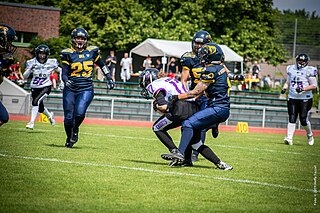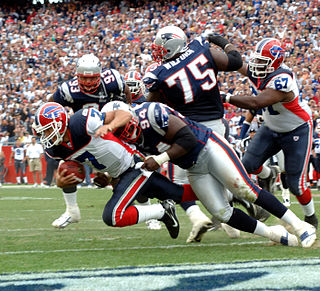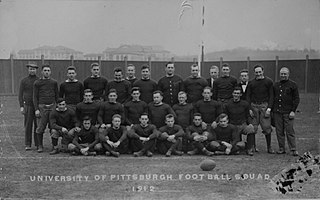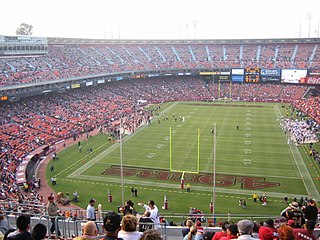
Touch football is an amateur variant of American football and Canadian football. The basic rules are similar to those of the mainstream game, but to end a down, the person carrying the ball need only be touched, instead of tackled, by a member of the opposite team. This rule change gave the game its name, to differentiate it from other variants. It is similar to street football, another amateur variant, however in street football full contact is allowed.

Gridiron football, also known as North American football, or in North America as simply football, is a family of football team sports primarily played in the United States and Canada. American football, which uses 11 players, is the form played in the United States and the best known form of gridiron football worldwide, while Canadian football, which uses 12 players, predominates in Canada. Other derivative varieties include arena football, flag football and amateur games such as touch and street football. Football is played at professional, collegiate, high school, semi-professional, and amateur levels.

A down is a period in which a play transpires in gridiron football. The down is a distinguishing characteristic of the game compared to other codes of football, but is synonymous with a "tackle" in rugby league. The team in possession of the football has a limited number of downs to advance ten yards or more towards their opponent's goal line. If they fail to advance that far, possession of the ball is turned over to the other team. In most situations, if a team reaches their final down they will punt to their opponent, which forces their opponent to begin their drive from further down the field; if they are in range, they might instead attempt to score a field goal.

American and Canadian football are gridiron codes of football that are very similar; both have their origins partly in rugby football, but some key differences exist between the two codes.
Strategy forms a major part of American football.

Gameplay in American football consists of a series of downs, individual plays of short duration, outside of which the ball is dead or not in play. These can be plays from scrimmage – passes, runs, punts or field goal attempts – or free kicks such as kickoffs and fair catch kicks. Substitutions can be made between downs, which allows for a great deal of specialization as coaches choose the players best suited for each particular situation. During a play, each team should have no more than 11 players on the field, and each of them has specific tasks assigned for that specific play.
In gridiron football, clock management is an aspect of game strategy that focuses on the game clock and/or play clock to achieve a desired result, typically near the end of a match. Depending on the game situation, clock management may entail playing in a manner that either slows or quickens the time elapsed from the game clock, to either extend the match or hasten its end. When the desired outcome is to end the match quicker, it is analogous to "running out the clock" seen in many sports. Clock management strategies are a significant part of American football, where an elaborate set of rules dictates when the game clock stops between downs, and when it continues to run.

In gridiron football, the safety or safety touch is a scoring play that results in two points being awarded to the scoring team. Safeties can be scored in a number of ways, such as when a ball carrier is tackled in his own end zone or when a foul is committed by the offense in its own end zone. After a safety is scored in American football, the ball is kicked off to the team that scored the safety from the 20-yard line; in Canadian football, the scoring team also has the options of taking control of the ball at its own 35-yard line or kicking off the ball, also at its own 35-yard line. The ability of the scoring team to receive the ball through a kickoff differs from the touchdown and field goal, which require the scoring team to kick the ball off to the scored-upon team. Despite being of relatively low point value, safeties can have a significant impact on the result of games, and Brian Burke of Advanced NFL Stats estimated that safeties have a greater abstract value than field goals, despite being worth a point less, due to the field position and reclaimed possession gained off the safety kick.

A comparison of American football and rugby union is possible because of the games' shared origins, despite their dissimilarities.
A comparison between American football and rugby league is possible because of their shared origins and similar game concepts. Rugby league is arguably the most similar sport to American football after Canadian football: both sports involve the concept of a limited number of downs/tackles and scoring touchdowns/tries takes clear precedence over goal-kicking.

The 2004 season was the Philadelphia Eagles' 72nd in the National Football League (NFL). The Eagles entered the season as back-to-back-to-back NFC runner ups and had been one of the most successful teams in the league after the Andy Reid and Donovan McNabb era began in 1999, making it to the playoffs for four straight seasons and to the NFC Championship Game in 2001, 2002, and 2003. However, the team could not reach the Super Bowl in any of those years, despite being favored in the latter two NFC title games. In the offseason, this already championship-level team was reinforced on both sides of the ball by the free agent additions of wide receiver Terrell Owens, defensive end Jevon Kearse and middle linebacker Jeremiah Trotter, their third-round draft pick in 1998.

The 2008 Florida Gators football team represented the University of Florida in the sport of American football during the 2008 NCAA Division I FBS football season. The Gators competed in the Football Bowl Subdivision (FBS) of the National Collegiate Athletic Association (NCAA) and the Eastern Division of the Southeastern Conference (SEC), and played their home games in Ben Hill Griffin Stadium on the university's Gainesville, Florida, campus. They were led by fourth-year head coach Urban Meyer.
The 2007 Poinsettia Bowl was a post-season American college football bowl game between the Navy Midshipmen and the Utah Utes played on December 20, 2007, at Qualcomm Stadium in San Diego, California. Utah defeated Navy 35–32 in a game that came down to the final seconds. The third edition of the Poinsettia Bowl was the first of 32 games in the 2007–2008 bowl season and the final game of the 2007 NCAA football season for both teams.
The game of lacrosse is played using a combination of offensive and defensive strategies. Offensively, the objective of the game is to score by shooting the ball into an opponent's goal, using the lacrosse stick to catch, carry, and pass the ball. Defensively, the objective is to keep the opposing team from scoring and to dispossess them of the ball through the use of stick checking and body contact or positioning.
The following terms are used in American football, both conventional and indoor. Some of these terms are also in use in Canadian football; for a list of terms unique to that code, see Glossary of Canadian football.

The Florida–LSU football rivalry, also known as the Swamp Bowl, is an American college football rivalry between the Florida Gators football team of the University of Florida and LSU Tigers football team of Louisiana State University. Although both universities were founding members of the Southeastern Conference (SEC) in December 1932, the Gators and Tigers did not meet on the gridiron until 1937, and have been annual opponents only since 1971. When the SEC instituted divisional play in 1992, Florida was placed in the SEC Eastern Division and LSU in the Western Division, and Florida and LSU were selected as permanent cross-division rivals. The Gators and Tigers have combined to win five national championships and eleven SEC titles over the past two decades.

The 1912 Pittsburgh Panthers football team was an American football team that represented the University of Pittsburgh as an independent during the 1912 college football season. In its fourth and final season under head coach Joseph H. Thompson, the team compiled a 3–6 record and was outscored by a total of 122 to 113.

The 1907 Western University of Pennsylvania football team was an American football team that represented Western University of Pennsylvania as an independent during the 1907 college football season.

The Catch II was the winning touchdown reception in a 1998 NFC Wild Card Game played between the Green Bay Packers and San Francisco 49ers at 3Com Park at Candlestick Point on January 3, 1999, as part of the 1998–99 NFL playoffs following the 1998 NFL season. With 8 seconds left in the game and the 49ers facing 3rd-and-3, San Francisco wide receiver Terrell Owens made a catch in the end zone to complete a 25-yard touchdown pass from quarterback Steve Young, enabling the 49ers to defeat the Packers, 30–27. It came at the end of a 9-play, 76-yard drive engineered by Young. This game and moment mirrors a similar catch in 49ers lore, when quarterback Joe Montana threw to receiver Dwight Clark in the 1981–82 NFL playoffs, and is similarly regarded as one of the most memorable events in National Football League (NFL) history, and a significant moment in Owens' NFL career.












